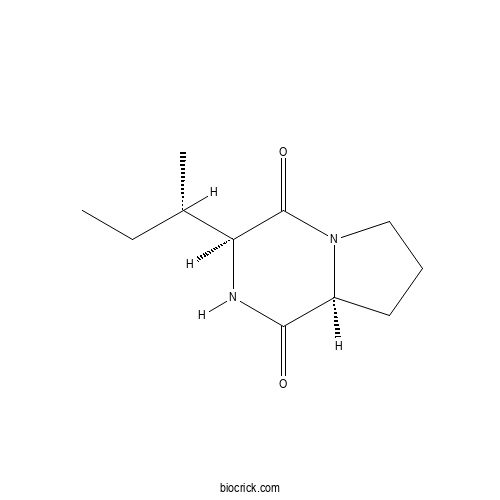Cyclo(L-Pro-L-Ile)CAS# 57089-60-8 |

Quality Control & MSDS
3D structure
Package In Stock
Number of papers citing our products

| Cas No. | 57089-60-8 | SDF | Download SDF |
| PubChem ID | 13654640 | Appearance | Oil |
| Formula | C11H18N2O2 | M.Wt | 210.27 |
| Type of Compound | Alkaloids | Storage | Desiccate at -20°C |
| Solubility | Soluble in Chloroform,Dichloromethane,Ethyl Acetate,DMSO,Acetone,etc. | ||
| Chemical Name | (3S,8aS)-3-[(2S)-butan-2-yl]-2,3,6,7,8,8a-hexahydropyrrolo[1,2-a]pyrazine-1,4-dione | ||
| SMILES | CCC(C)C1C(=O)N2CCCC2C(=O)N1 | ||
| Standard InChIKey | ZDACRNZBFJOLTC-CIUDSAMLSA-N | ||
| Standard InChI | InChI=1S/C11H18N2O2/c1-3-7(2)9-11(15)13-6-4-5-8(13)10(14)12-9/h7-9H,3-6H2,1-2H3,(H,12,14)/t7-,8-,9-/m0/s1 | ||
| General tips | For obtaining a higher solubility , please warm the tube at 37 ℃ and shake it in the ultrasonic bath for a while.Stock solution can be stored below -20℃ for several months. We recommend that you prepare and use the solution on the same day. However, if the test schedule requires, the stock solutions can be prepared in advance, and the stock solution must be sealed and stored below -20℃. In general, the stock solution can be kept for several months. Before use, we recommend that you leave the vial at room temperature for at least an hour before opening it. |
||
| About Packaging | 1. The packaging of the product may be reversed during transportation, cause the high purity compounds to adhere to the neck or cap of the vial.Take the vail out of its packaging and shake gently until the compounds fall to the bottom of the vial. 2. For liquid products, please centrifuge at 500xg to gather the liquid to the bottom of the vial. 3. Try to avoid loss or contamination during the experiment. |
||
| Shipping Condition | Packaging according to customer requirements(5mg, 10mg, 20mg and more). Ship via FedEx, DHL, UPS, EMS or other couriers with RT, or blue ice upon request. | ||

Cyclo(L-Pro-L-Ile) Dilution Calculator

Cyclo(L-Pro-L-Ile) Molarity Calculator
| 1 mg | 5 mg | 10 mg | 20 mg | 25 mg | |
| 1 mM | 4.7558 mL | 23.779 mL | 47.5579 mL | 95.1158 mL | 118.8948 mL |
| 5 mM | 0.9512 mL | 4.7558 mL | 9.5116 mL | 19.0232 mL | 23.779 mL |
| 10 mM | 0.4756 mL | 2.3779 mL | 4.7558 mL | 9.5116 mL | 11.8895 mL |
| 50 mM | 0.0951 mL | 0.4756 mL | 0.9512 mL | 1.9023 mL | 2.3779 mL |
| 100 mM | 0.0476 mL | 0.2378 mL | 0.4756 mL | 0.9512 mL | 1.1889 mL |
| * Note: If you are in the process of experiment, it's necessary to make the dilution ratios of the samples. The dilution data above is only for reference. Normally, it's can get a better solubility within lower of Concentrations. | |||||

Calcutta University

University of Minnesota

University of Maryland School of Medicine

University of Illinois at Chicago

The Ohio State University

University of Zurich

Harvard University

Colorado State University

Auburn University

Yale University

Worcester Polytechnic Institute

Washington State University

Stanford University

University of Leipzig

Universidade da Beira Interior

The Institute of Cancer Research

Heidelberg University

University of Amsterdam

University of Auckland

TsingHua University

The University of Michigan

Miami University

DRURY University

Jilin University

Fudan University

Wuhan University

Sun Yat-sen University

Universite de Paris

Deemed University

Auckland University

The University of Tokyo

Korea University
- Cyclo(L-Pro-L-Val)
Catalog No.:BCX0219
CAS No.:2854-40-2
- Demethylmangostanin
Catalog No.:BCX0218
CAS No.:2289591-37-1
- Cyclo(L-Leu-L-Pro)
Catalog No.:BCX0217
CAS No.:2873-36-1
- 25,26,27-Trinor-3α-hydroxycycloartan-24-oic acid
Catalog No.:BCX0216
CAS No.:1300747-31-2
- 3'-Hydroxyliquiritin
Catalog No.:BCX0215
CAS No.:1442113-42-9
- Atalafoline
Catalog No.:BCX0214
CAS No.:59-49-4
- (2R,3S)-Pterosin C
Catalog No.:BCX0213
CAS No.:68399-17-7
- Gnetuhainin O
Catalog No.:BCX0212
CAS No.:337464-95-6
- Pratorimine
Catalog No.:BCX0211
CAS No.:88660-12-2
- Fibraurin
Catalog No.:BCX0210
CAS No.:25254-84-6
- 1-Epideacetylbowdensine
Catalog No.:BCX0209
CAS No.:101219-55-0
- Copalic acid
Catalog No.:BCX0208
CAS No.:24470-48-2
- Fornicin A
Catalog No.:BCX0221
CAS No.:908588-41-0
- 3β,5α-Dihydroxystigmastan-6-one
Catalog No.:BCX0222
CAS No.:55051-78-0
- 4-(1-Ethoxy-2-hydroxyethyl)benzene-1,2-diol
Catalog No.:BCX0223
CAS No.:1190632-33-7
- Phenacetamide
Catalog No.:BCX0224
CAS No.:103-81-1
- 1,6,8-Trihydroxy-2,7-dimethoxy-3-methylanthraquinone
Catalog No.:BCX0225
CAS No.:2366153-27-5
- 1,3,5,7-Tetrahydroxy-8-prenylxanthone
Catalog No.:BCX0226
CAS No.:444004-76-6
- 22-Epiinotodiol
Catalog No.:BCX0227
CAS No.:64907-49-9
- Brasilixanthone B
Catalog No.:BCX0228
CAS No.:84002-57-3
- Makisterone A
Catalog No.:BCX0229
CAS No.:20137-14-8
- Apigenin 6-C-(2-O-feruloyl)glucoside 8-C-glucoside
Catalog No.:BCX0230
CAS No.:1287786-63-3
- Fibleucin
Catalog No.:BCX0231
CAS No.:24278-14-6
- N-Acetylnornuciferine
Catalog No.:BCX0232
CAS No.:1942-03-6
Bioactive 2(1H)-Pyrazinones and Diketopiperazine Alkaloids from a Tunicate-Derived Actinomycete Streptomyces sp.[Pubmed:27563872]
Molecules. 2016 Aug 24;21(9):1116.
As a part of our ongoing effort to allocate marine microbial bioactive leads, a tunicate-derived actinomycete, Streptomyces sp. Did-27, was investigated. Three new 2(1H)-pyrazinones derivatives, (S)-6-(sec-butyl)-3-isopropylpyrazin-2(1H)-one (1), (S)-3-(sec-butyl)-6-isopropylpyrazin-2(1H)-one (2) and (S)-6-(sec-butyl)-3-isobutylpyrazin-2(1H)-one (3), together with the known (1H)-pyrazinones analogues deoxymutaaspergillic acid (4), 3,6-diisobutyl-2(1H)-pyrazinone (5) and 3,6-di-sec-butyl-2(1H)-pyrazinone (6), and the diketopiperazine alkaloids cyclo(6-OH-d-Pro-l-Phe) (7), bacillusamide B (8), cyclo(l-Pro-l-Leu) and Cyclo(L-Pro-L-Ile) (10) were isolated from this strain. The structures of the compounds were determined by study of their one- and two-dimensional NMR spectra as well as high-resolution mass spectral determinations. Compound 4 was reported previously as a synthetic product, while compound 6 was reported as 2-hydroxy-3,6-di-sec-butylpyrazine. Herein, we report the complete NMR data for compounds 4 and 6. The compounds were evaluated for their cytotoxic activities against three cell lines. Compound 5 showed potent and selective activity against HCT-116 cell line with IC50 of 1.5 mug/mL, while 1-10 showed variable cytotoxic activities against these cancer cell lines. These results provide further understanding about the chemistry and bioactivities of the alkylated 2(1H)-pyrazinone derivatives.


